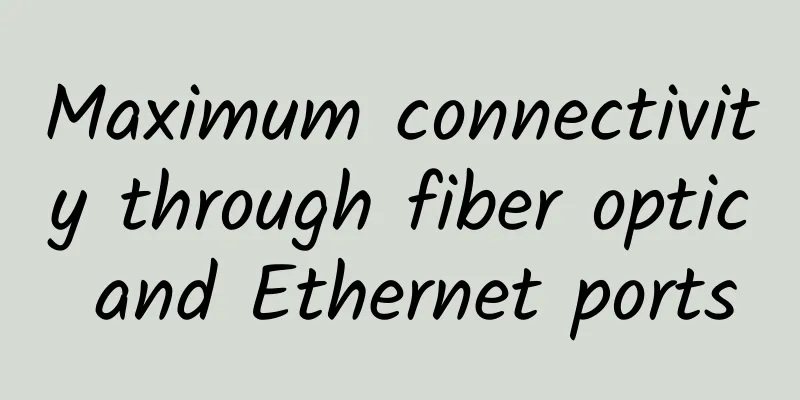|
In today's digital environment, high-speed data transmission and reliable network connections are critical to organizations. One powerful solution to achieve these goals is to connect fiber optic cables with Ethernet ports. This comprehensive guide will explore the importance and benefits of this integration, provide an understanding of fiber optic cables and Ethernet ports, discuss their compatibility, and provide a step-by-step process for connecting. Understanding Fiber Optic Cables and Ethernet Ports- Fiber Optic Cable: Fiber optic technology has revolutionized data transmission by using thin, optically pure glass or plastic threads to transmit data via light signals.
It has notable features such as high bandwidth capacity, immunity to electromagnetic interference, low latency, and lightweight design. Fiber optic cables come in different sizes, including single-mode fiber (SMF) and multimode fiber (MMF), each suitable for specific applications based on distance and bandwidth requirements.
Additionally, for short-distance applications, plastic optical fiber (POF) is a more affordable option. - Ethernet Port: An Ethernet port is a physical interface on a network device that enables the device to connect to a local area network (LAN).
It acts as a gateway for data packets, facilitating communication between devices within the network.
Different types of Ethernet ports include the widely used RJ45 port, as well as SFP (Small Form Factor Pluggable), SFP+ (Enhanced Small Form Factor Pluggable), QSFP (Quad Small Form Factor Pluggable), etc.
Ethernet ports play a vital role in data transmission, allowing devices to exchange data using the Ethernet protocol. Benefits of Integrating Fiber Optic Cables with Ethernet Ports- Enhanced data transfer speeds and bandwidth capabilities: Integrating fiber optic cables with Ethernet ports unlocks the potential for higher data transfer speeds and greater bandwidth capacity compared to traditional copper-based solutions. Fiber optic cables can support speeds from 10 Mbps to multiple megabits per second, enabling organizations to meet the demands of high-bandwidth applications such as video streaming, cloud computing, and data-intensive tasks.
- Extended range and distance coverage: Fiber optic cables have a clear advantage over copper cables in terms of transmission distance. The transmission distance of copper cables is limited to a few hundred meters, while fiber optic cables can transmit data over longer distances without signal degradation. Single-mode fiber optic cables, in particular, can cover distances from a few kilometers to tens of kilometers, making them ideal for connecting remote locations or bridging long distances within a network.
- Improved reliability and reduced latency: Fiber optic cables offer higher reliability than copper cables. They are immune to electromagnetic interference, ensuring stable data transmission even in environments with high levels of electrical noise or radio frequency interference. This interference resistance minimizes data loss, signal degradation, and downtime, resulting in more reliable network connections. In addition, fiber optic cables have lower latency, allowing for near-instant data transmission, which is critical for real-time applications such as video conferencing, online gaming, and financial trading.
- Resistance to electromagnetic interference: One of the main advantages of fiber optic cables is resistance to electromagnetic interference (EMI). Unlike copper cables, which can be affected by nearby power lines, electrical equipment, or radio frequencies, fiber optic cables are not susceptible to such interference. This makes fiber-based networks highly reliable and stable, especially in environments with a high concentration of electronic devices or electromagnetic activity. It ensures consistent network performance and minimizes the risk of data loss or corruption.
Fiber optic cable and Ethernet port compatibility Before integrating fiber optic cables with Ethernet ports, it is critical to consider the compatibility between the two technologies. This involves understanding the hardware requirements for integration, the installation and setup process, and considerations for compatibility and scalability. - Hardware requirements for integration: To integrate fiber optic cables with Ethernet ports, you need to install the appropriate hardware components. These include media converters, transceivers, and switches.
- Media Converter: A media converter is a device that helps convert electrical signals from an Ethernet port into optical signals that can be transmitted over a fiber-optic cable. It acts as an intermediary between the copper-based Ethernet port and the fiber-optic cable.
- Optical modules: Optical modules are mainly used for conversion between electrical and optical signals, such as SFP or SFP+ modules. These hot-swappable modules fit into compatible Ethernet switches or network interface cards (NICs) and support direct integration of fiber optic cables into network infrastructure.
- Switches: Ethernet switches with built-in fiber optic ports allow fiber optic cables to be integrated directly into the network infrastructure. These switches support the transmission of Ethernet signals over fiber optic cables, enabling seamless connectivity between devices.
Installation and Setup Process To integrate a fiber optic cable with an Ethernet port, refer to the following steps: - Prepare the fiber optic cable: First, measure the fiber optic cable correctly and cut it to the required length. Make sure there is enough slack for installation. Then, use a fiber optic stripping tool to strip the protective coating on the end of the cable and clean the exposed optical fiber with a lint-free wipe and isopropyl alcohol to ensure a clean connection.
- Terminate fiber optic cable: Install a connector, such as LC (Lucent connector) or SC (Subscriber connector), on the end of a fiber optic cable. These connectors align and secure the fiber to ensure efficient light transmission. Follow the manufacturer's instructions for installing the connector, including cutting the fiber, applying epoxy or mechanical splices, and polishing the connector for optimal performance.
- Prepare the Ethernet port: Verify compatibility and availability of an appropriate Ethernet port that supports fiber optic integration. Inspect the port for any dust, debris, or physical obstructions that could interfere with the connection. Use compressed air or a fiber optic cleaning tool to remove any contaminants and ensure the connection interface is clean.
- Connect the fiber optic cable to the Ethernet port: Carefully insert the fiber optic cable connector into the Ethernet port, aligning the keying mechanism if applicable. Gently push the connector until it clicks into place or tighten it using the provided locking mechanism. Ensure a secure, tight connection to prevent signal loss or disconnection.
- Test and verify connections: To ensure successful integration, perform optical power and link tests. Optical power meters can be used to measure the strength of light signals transmitted through fiber optic cables. Link testing involves using network test tools or software to verify data transmission and connectivity between connected devices. These tests help identify any potential problems, such as signal loss, improper alignment, or connector failures, and make adjustments or repairs if necessary.
Integration challenges and solutions While integrating fiber optic cables with Ethernet ports offers significant advantages, there are still challenges to consider: - Cost considerations and required investments: Integrating fiber optic cables with Ethernet ports may require an initial investment in hardware and equipment. The upfront costs of fiber optic cables, media converters, optical modules, and switches may be higher than traditional copper-based solutions. However, the long-term benefits, including enhanced performance, scalability, and reduced maintenance costs, must be considered.
- Maintenance and Troubleshooting: Regular maintenance, including cleaning and inspection of connectors, is essential to ensure optimal performance. Over time, fiber optic connectors can accumulate dust, dirt, or contaminants that can affect signal quality. Regular cleaning and inspection of connectors, as well as monitoring for any signs of signal degradation or disconnection, are necessary to maintain reliable connections. If connection issues or signal degradation occur, troubleshooting techniques such as checking connections, verifying configurations, or seeking professional assistance may be necessary.
- Compatibility issues and interoperability: Ensuring compatibility between fiber optic cables, optical modules, and Ethernet ports is critical. Different types of fiber optic connectors (LC, SC, etc.) and transceiver modules (SFP, SFP+, etc.) may have specific compatibility requirements. Consulting an expert, referring to the compatibility guide provided by the manufacturer, or seeking professional assistance can help resolve any compatibility issues and ensure seamless interoperability.
Summarize Integrating fiber optic cables with Ethernet ports provides organizations with high-speed data transmission, reliable network connectivity, and improved network performance. By following the proper integration steps, considering compatibility and scalability, and performing necessary testing, organizations can build a robust and efficient network infrastructure. Unleash the full potential of your network by leveraging the power of fiber optic technology and Ethernet ports. With careful planning, implementation, and maintenance, you can enjoy benefits such as seamless data transmission, extended coverage, improved reliability, and enhanced network performance. |










